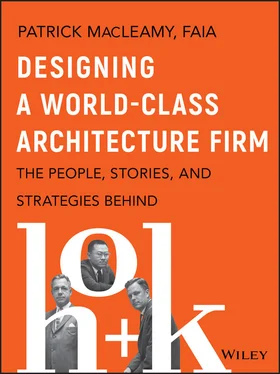This ownership relationship required HOK to operate in a more businesslike way. The founders never took all the money out of the firm at the end of the year as a partnership might, instead reinvesting some of each year's profit back into the company. They made good livings, but never became fabulously wealthy, because they chose to put money back into the company. They had a bigger mission in mind than just dollars—they were investing in the long-term future of the firm.
The founders developed a plan to offer stock to key employees as a method of expanding ownership to the next generation of leaders. Their goal was to create a virtuous cycle. As senior leaders retired, upcoming leaders would become owners. They also invited a handful of those next-generation leaders to serve as HOK board members. Board members did not have much power, which stayed with the small committee of founders running the firm, but they got a chance to learn and brought in their own fresh ideas and new perspectives. Board membership would become so important later that we would restructure the firm to create more opportunities for future leaders.
Another advantage of offering employees stock was that the additional stock sold to younger employees consisted of newly issued shares, not the original stock held by the founders. By selling stock to employees rather than giving it to them, the value of HOK increased by the amount of money the new owners put into the firm. Thus, HOK stock was not diluted, and retained its value. The founders began to offer HOK stock to younger people well before any of the three approached the mandatory age when they had to sell their stock back to the company. In the years before I joined the firm, the founders offered stock to only a few key employees. But in 1968, they conducted the first large-scale stock sale to about 20 selected employees. I was fortunate to be included in that group.
It's important to note that HOK did not give stock to its employees. Rather, the firm sold stock to us—just like any corporation would—and we had to come up with the money to buy it. HOK made this process almost painless by arranging with Boatmen's Bank, HOK's corporate bank at that time, to extend an automatic loan to any employee buying stock. HOK received the loan proceeds in exchange for the stock, and the employee paid off the loan over the course of a few years, with an automatic payroll deduction.
When HOK offered me this ownership opportunity, I was still wondering if I should stay with the firm. Having a piece of the ownership gave me a seat at the annual shareholders meeting and made me feel like part of something bigger. It cemented me to HOK in ways I didn't entirely understand at the time. Buying that stock was one of the smartest things I ever did. Later, I would use stock ownership to reunify HOK, after we had lost our way.
Chapter 3: To Design a World-Class Firm
1 Listen to potential clients before you talk, to learn what they really want and need, and you will be an outstanding marketer.
2 Listen to clients before you design, and you will be a better designer who comes up with the most innovative solutions.
3 Prioritize designing beautiful but functional buildings that really work for your clients over developing a recognizable personal style.
4 Balance the natural tension between quality and schedule to get the best buildings completed on time and on budget.
5 Innovate with the tools of your time. Discover new ways to use them—whether to be more organized or to create better designs.
6 Get out into the world and help your city or client make good decisions about their building needs before design even starts.
7 Assign the designer, project manager, and technical architect to a job at the start and have them see it all the way through.
8 Bring other professions—from graphics to interiors, from PR to law—in house for closer collaboration.
9 Invest some cash back into your firm every year, rather than distributing all of it to the partners, so you can grow or improve your practice.
10 Consider setting up your firm as a corporation, meant to outlive you, rather than as a partnership that dies with the partners.
11 Restrict stock ownership to active employees, so you can control your company and its destiny.
12 Create a virtuous cycle by offering to sell newly issued shares of stock to younger employees, as the company grows. This will build loyalty—and your firm's value.
1 1Walter McQuade and Paul Grotz, Architecture in the Real World: The Work of HOK (New York: H.N. Abrams, 1985), p. 27.
2 2Ibid., 28.
3 3Roger Friedland and John W. Mohr, Matters of Culture: Cultural Sociology in Practice (Cambridge: Cambridge University Press, 2006).
4 4“Top Architect Advises Involvement Beyond Duties,” The Oregonian, June 24, 1968.
CHAPTER 4 Company Culture Is Crucial
George Hellmuth, Gyo Obata, and George Kassabaum were different people with different personalities, but they shared a powerful vision of a firm where people treated each other as teammates and helped each other to succeed. They valued harmony. Plenty of rivalry existed outside the firm for projects, but inside, the founders insisted that teamwork was the best way for HOK to compete. To simplify this thought, which would work well at any company, the idea was:
Collaboration inside is the best way to compete outside.
My friend Bill Voelker had described the atmosphere as that of “a big family,” and I came to think of it as HOK culture. People at the firm really did do their utmost to help each other succeed. When I came to HOK, the firm had such a unified culture that everyone shared a common frame of reference. I heard many HOK leaders say, “If you don't fit into the HOK culture, you are going to leave sooner or later, and you might as well leave sooner!”
HOK was remarkably egalitarian, with a sense of mutual respect between everyone from file clerk to founder. This was most important in the quest for new and better ways to do things. The founders actively encouraged people to seek out the very best ideas and solutions, regardless of who they came from—an enlightened approach any firm could adopt. We were encouraged to innovate and take risks, even if it didn't always work out. If a junior employee dreamt up the best idea, senior people set their egos aside and went with it. Period. This was a real novelty at a time when most companies took a top-down approach. Architecture has at times suffered from a cult of personality, where so-called “black cape” architects demanded total obedience from their apprentices. HOK was different.
The founders also demonstrated mutual respect by using first names around the office. People called Kassabaum “George K.” and Hellmuth “George H.” Later, people started calling George H. “Papa George,” when his son—also an architect and named George Hellmuth—came to work at HOK. I called Gyo Obata “Mr. Obata” during my interview, but he soon corrected me, and he was always “Gyo” after that. It was a first-name-basis kind of place. In fact, as I write this book, it makes me faintly uncomfortable to refer to the founders by their last names, but with so many Georges and Bills and Bobs, I have done so for clarity. (I have called later leaders by their first names.)
Part of mutual respect at HOK was self-responsibility. The firm relied on everyone to do the right thing. In fact, no one filled out a time sheet. Staff members were mostly salaried, and each person was expected to be diligent in his or her work. Obata himself always came in on Saturdays, so his team did, too. People worked, as needed, until a job was finished. It was also normal to see people working at night. In return, HOK respected our efforts and made it possible to do this with the least amount of stress. If people had to work late, HOK fed them and the founders lauded their work at the next staff meeting. It was part of the family feel. People treated each other with respect, were patient with each other's shortcomings, and celebrated both personal and firm growth.
Читать дальше












